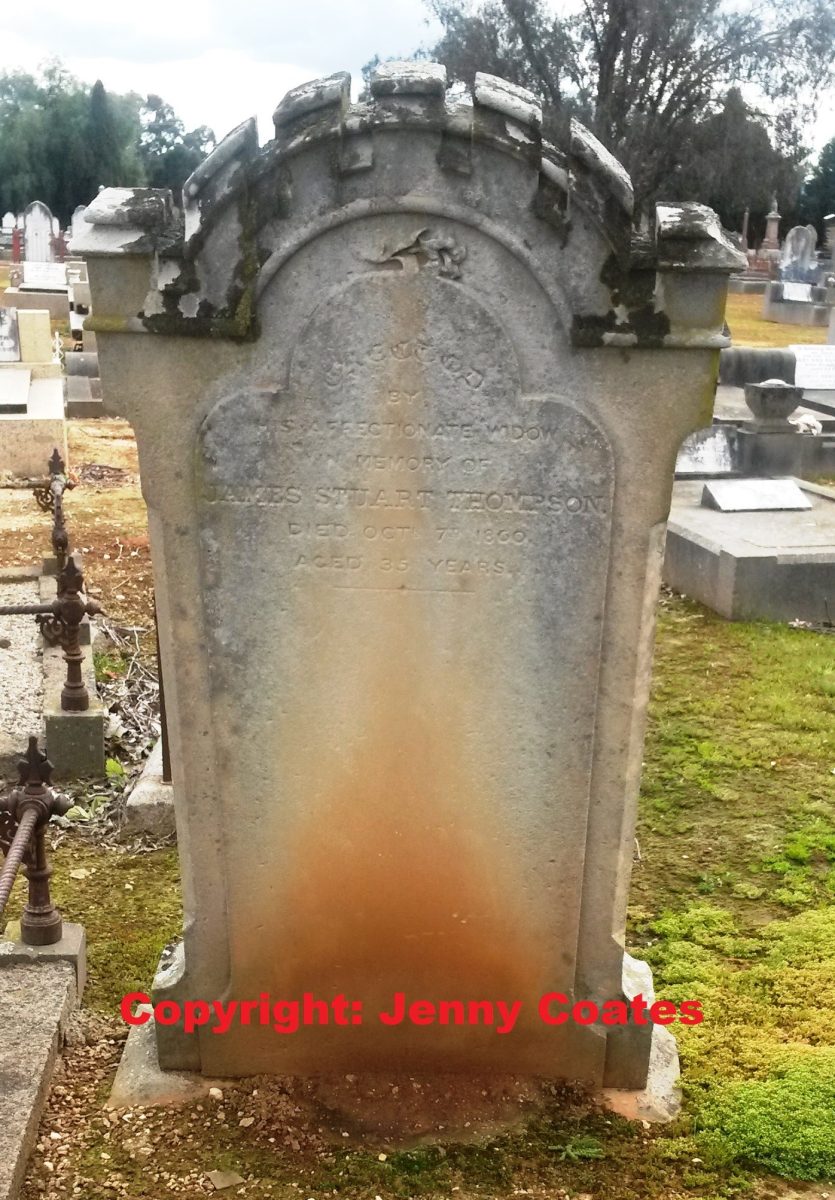The Beyond the Headstones series of posts was inspired after having spent a bit of time in Wangaratta cemetery, visiting loved ones, attending funerals or wandering around taking photos. In some sections I have been known to point at a headstone and exclaim “I know her!” Aside from the weird looks I get from my companions, what I mean to say is that I have some personal knowledge or research that brings the person commemorated on the headstone to life. They are no longer merely a name with a dash between two dates. They are people who can be remembered for the lives that they lived, and not just represented by a cold, mute stone.
Thompson headstone, Wangaratta cemetery. Copyright: Conversations With Grandma
This early headstone in Wangaratta cemetery was erected for James Stuart Thompson, the husband of Agnes Wills. James was born in Claughton, Lancashire where his father William was an inn-keeper. He was baptised on the 15th May 1825 at Garstang, Lancashire and given the surname of his mother Agnes Stuart.
As with many deaths in Wangaratta in the 1860s, either the death of James was not registered, or the registration has not survived. Therefore, we have no hint of when he came to Australia, and it is impossible to identify him in passenger records. We do know that James was residing in Wangaratta by February 1859 when he married Agnes Wills at Trinity Church in Wangaratta. Agnes was from Tarrawingee. By 1860 the couple were living at Docker’s Plains. Witnesses to the marriage were Thomas Wills (brother of Agnes), and Ellen Newman (sister of Agnes). On the 7th October James left his home at Dockers Plains to look for strayed horses. He was not seen alive again.
At the inquest held at the Wangaratta Hotel three weeks later when his body was found, the jury, led by coroner William Augustus Dobbyn, determined that “the deceased James Stewart [sic] Thompson was found drowned in Mr Docker’s paddock on the 29th day of October 1860.” These days we would not accept this statement of the obvious, but 160 years ago inquests could do little except determine if any obvious foul play was involved.
The body of James was laid to rest in the Church of England section of the Wangaratta cemetery, in plot 426 N. The Wangaratta cemetery data CD unfortunately omits any information on other occupants of this grave. Agnes applied for probate of her husband’s £600 estate and was successful, with the assistance of Joseph Wills of Oxley (another brother), and local builder Samuel Ashworth who both acted as guarantors. No children have been found as being registered to James and Agnes, but the lack of surviving birth registrations from the period may mean that one or two children are unknown to us.
So what happened to Agnes? She inherited a sizeable sum and was therefore an attractive spousal prospect. Given the difficulty of identifying a remarriage for a woman with such a common name, I reconstructed her nuclear family, noting any siblings in the district. Agnes had five brothers and two sisters in the area, and I was hoping that the obituary of one of these siblings might give a married name of Agnes, if not where she was living. Her siblings did not have any substantial obituaries, except for the youngest, Edmund. Edmund died at Hurdle Creek in 1882 and his obituary stated that he had arrived in Victoria “thirty years ago”. The obituary also stated that he had travelled with Mr James Thompson! This surely couldn’t be a coincidence. Agnes must have married her brother’s ship mate.
I then analysed the marriages of the six women named Agnes Thompson who married between 1861 and 1870. Due to the vagaries of the Victorian BDM online index, when I first did this I was not able to find an Agnes, with any surname, and with a father whose surname was Wills. That would have made the search so much easier but the database kept telling me there was no result. This time, by following the marriage of each Agnes through, I was able to determine that she had married twice more. Her second marriage was to Thomas Goodyear in 1862. Agnes was widowed again in 1872 when Thomas died at Oxley Plains, aged only 50. She then married Henry Hine in 1875. Interestingly, after she became Mrs Hine, Agnes erected a headstone to her second husband and his mother at Milawa cemetery, noting herself as the “affectionate widow” of Thomas. Agnes joined Thomas in this grave in 1891.






